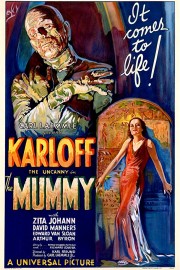The Mummy (’32)
I’ve watched Hammer’s 1958 version of “The Mummy” so much that I pretty much forgot how good the 1932 Universal film is. Universal’s monster movies, at least, the first ones they made with the respective monsters, evoked a dread and atmosphere that sets them apart from the theatricality of Hammer’s work, and that is on full display in Karl Freund’s film, which was inspired recent discovery of Tutankhamun’s tomb, and tells a dark love story that is as haunting to watch as its images.
The film begins in 1921, as a team of archeologists from England are digging in Egypt, and have come across a mummy and its artifacts. One of the members of the team opens one, particular artifact (a scroll with a curse on it), and sure enough, the mummy wakes up, and walks away with the scroll, with the team member driven insane, later to die institutionalized. Cut to a decade later, and the team leader’s son (Frank Whemple, played by David Manners) is leading another expedition, but with little luck, until a local named Ardeth Bay (Boris Karloff) directs them to a place where an ancient princess, Ankh-es-en-amon, is buried. It may not be the discovery they were expecting, however, as Ardeth Bay seems to have the same scroll that was taken a decade before.
Freund was a legendary cinematographer before he got his first attempt at directing in America with “The Mummy”- he had previously shot Universal’s “Dracula” for Todd Browning- and his eye for creating terrifying and unforgettable imagery carries over to his efforts in directing this film. What’s so beautiful about this film- and indeed, many of the Universal horror films in this era- was how it expanded on the German Expressionist visual ideas in films such as “Nosferatu” and “The Cabinet of Dr. Caligari,” and brought it to American cinema, with Freund’s work on the Universal horror movies being its first, real showcase, and it eventually made its way into the creation of film noir, and has a foot remaining in many genre films to this day. It’s obvious, looking at it now, that these films were all on sets on the Universal lot and matte paintings, but the visual flair people like Freund brought to the films make them feel real and unsettling, even today.
I think the thing that made “The Mummy” stand out the most for me, though, was the way it builds the mythology of the Mummy, and how it unfolds. Freud flashes back to ancient Egypt in scenes that appear as though they are being shown on a television monitor, but the way it is played out in the modern scenes by Karloff, whose Bay is the living version of the mummy, Imhotep, who has assimilated himself into present day Egypt, and has a reason for sending Frank’s team on the expedition they find themselves on for the princess, especially when Helen Grosvenor, a half-Egyptian woman played by Zita Johann, comes in the path of the story, and she bears a striking resemblance to the princess. This basically became the template for every movie about a mummy to come, including the 1999 action adventure with Brendan Fraser. Very few have come quite as close to accomplishing the greatness of what Freund’s film did here.










